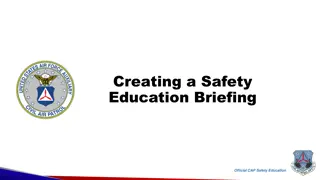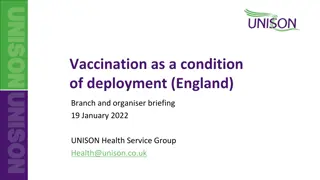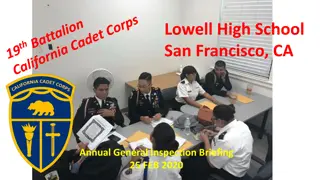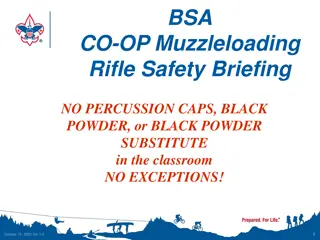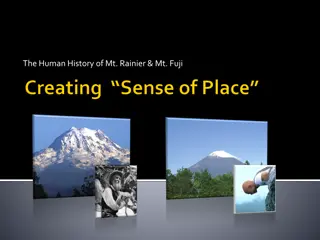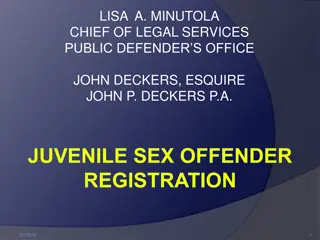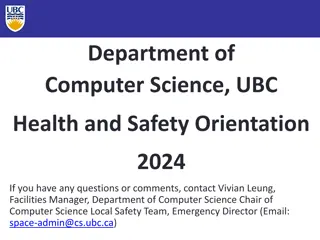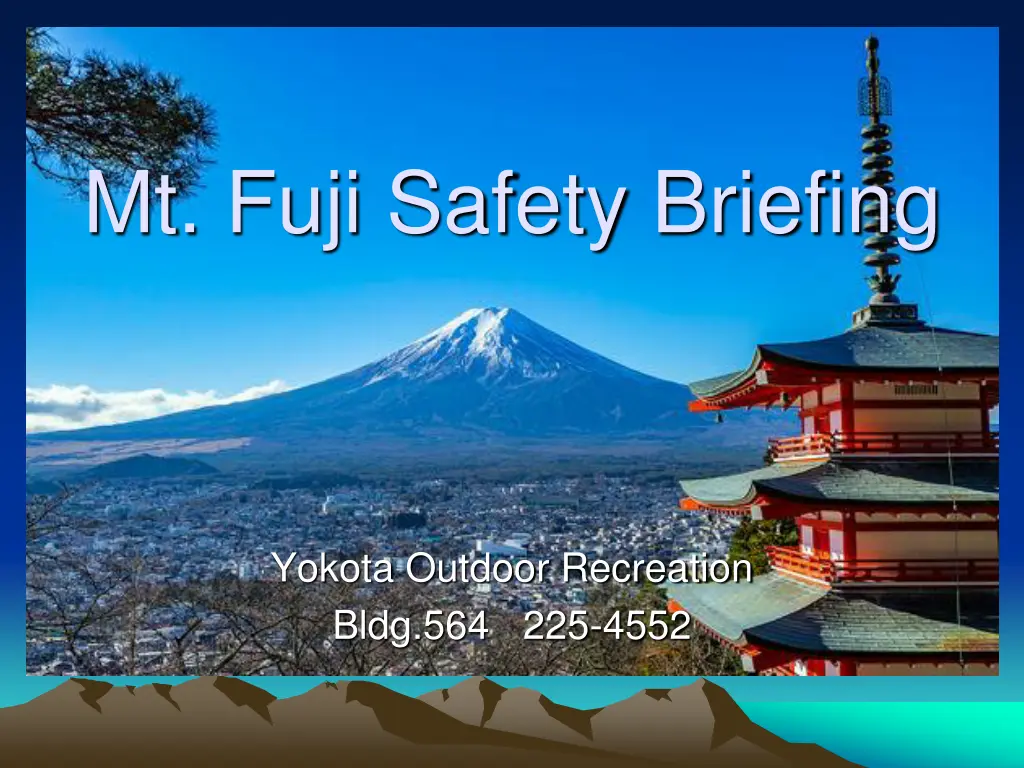
Exploring Mt. Fuji - Safety Briefing and Climbing Tips
Discover essential safety briefing information and climbing tips for tackling the iconic Mt. Fuji, the highest mountain in Japan. Learn about the challenging ascent routes, average temperatures, descent paths, time estimates at various stations, and important preparation guidelines to help you successfully conquer this breathtaking peak.
Download Presentation

Please find below an Image/Link to download the presentation.
The content on the website is provided AS IS for your information and personal use only. It may not be sold, licensed, or shared on other websites without obtaining consent from the author. If you encounter any issues during the download, it is possible that the publisher has removed the file from their server.
You are allowed to download the files provided on this website for personal or commercial use, subject to the condition that they are used lawfully. All files are the property of their respective owners.
The content on the website is provided AS IS for your information and personal use only. It may not be sold, licensed, or shared on other websites without obtaining consent from the author.
E N D
Presentation Transcript
Mt. Fuji Safety Briefing Yokota Outdoor Recreation Bldg.564 225-4552
Fuji Facts It s the 2nd largest single mountain in the world and it s as high as 8.5 Empire State Buildings. This hike will require little expertise and the proper equipment, not doing so may result in serious injury or even death.
Highest mountain in Japan 12,388 ft (3,776 m) Anyone in good physical condition can climb Mt. Fuji, although it is not easy and should be approached as a physical and mental challenge.
40 (4 ) ! This is the average temp. in mid- summer on the summit. It can even get colder depending on the weather. It is usually very cold in the morning and during the night, even in summer.
Descent Route Ascent Route Main split, go left ! The path to the right will take you into Shizuoka Prefecture. Ascent: 5-8 hours Descent: 3-5 hours ( average time ) Fuji-Yoshida Route : The most popular route to climb to the summit. 5th Station Bus Terminal
PM 1:00 PM 1:00 Summit 3,776m 30-50 min PM 12:20 9th Station 3,576m 25-45 min 30-45 min AM 11:40 Goraikokan 8th Sta. Tomoekan Fujisan Hotel Gansomuro Hakuunso Horaikan Taishikan Toyokan Toriiso Fujiichikan Kamaiwakan 7th Sta. Tomoekan Hinodekan Hanagoya 8.5th Station 3,454m 30-50 min AM 11:00 PM 1:45 Main 8th St.3,374m 50-80 min AM 09:40 8th Station 3,040m 115-190 min 60-95 min AM 08:10 7th Station 2,700m Descent Route 7th Station PM 4:55 60-95 min 25-40 min AM 06:35 PM 5:35 6th Sta. Safety Guidance Center 0555-24-6223 15-25 min 40-65 min AM 05:30 PM 6:00 5th Station 2,305m Time limit at each station to ensure not missing the bus !!
Dont get lost ! Trail signs are color coded to match specific routes. Be careful not to take a wrong descending trail. Be sure to follow correct signs colored in yellow. Key words ! Yoshida Trail Kawaguchiko-town Subaru-line Yamanashi prefecture
Preparation Limit caffeine & alcohol 24 hours prior Get lots of sleep (at least 8 hours of sleep) Attain proper equipment
Packing Go through the supply checklist in the Mt. Fuji pamphlet. Remember to pack necessities only and avoid nice to have supplies. Less weight also means better balance.
Equipment & Supplies An absolute minimum set of clothing for climbing Fuji would be:
Hiking boots (No Sneakers) The rocky, steep terrain in some sections are reasons to bring proper hiking shoes which protect and support your ankles. Available for rent.
Rain gear (No Poncho) Bring rain gear, as weather conditions can change very quickly on the mountains. Available for rent. Rain or shine we will climb Mt. Fuji
Prevent sunburn Head cover, sunglasses, long-sleeve shirt and sunscreen are items to protect yourself from sunburn. You will be subjected to direct sunlight all day.
Backpack Bring along 25-40 liter backpack with a shoulder and hip belt. Available for rent.
High calorie food, snacks & drinks It is important to bring enough water and food. Bring along at least 1.0 liter of water per person. Mountain huts offer various meals and drinks. However, the prices increase with the altitude.
Headlamp or flashlight & extra batteries Most people choose head lamps, as they leave both of your hands free. Available for rent.
Gloves Gloves are also strongly recommended to protect against the coldness and for hiking the steep and rocky passages. Available for purchase.
Clothing (No Jeans) No cotton or jeans because once wet, your body core temp. will drop quickly and it will not dry so quick.
Clothing (Layers) It is advisable to dress in removable layers such as a base layer, T-shirt, sweater and light jacket so that you will not be too hot while hiking and not too cold at the summit. Long-sleeve shirt is strongly recommended to protect yourself from sunburn.
Helmet After more than 60 people died when a nearby volcano, Mt. Ontake erupted without warning in 2014, we will strongly urge climbers to be equipped with a helmet, dust mask and goggles. Even bike helmet is better than nothing.
Helpful Items Oxygen is an effective tool in preventing and fighting altitude sickness (available for purchase) Trekking poles for better balance and support (available for rent) Camera for the spectacular views!
Other supplies Plastic bags for garbage or to keep items in your backpack dry Small towel (for sweat or dust) Extra Japanese-yen Bandages, aspirin or other pain reliever Change of clothes (you can leave it on the bus)
Expenses Mt. Fuji Trail admission fee 4,000 Climbing stick & stamps Toilet fees (toilets are pay-per-use and cost 200-300 yen) Emergency water, food or oxygen Train or taxi fare (in case you get lost) Total suggested 20,000 & 100 coins
Souvenir climbing sticks Can purchase at Mt. Fuji.
Souvenir stamps (200-500yen) You can have your hiking stick stamped at the huts.
Climbing Precaution Set a slow and steady pace from the beginning and avoid overexertion. It is better to take frequent short breaks rather than to stop only a few times for long periods of rest. Prevent dehydration.
The beginning at the 5th station
Safety Refrain hiking away from marked trails and watch your step. Rock slides are frequent. If you see or hear a rock slide, shout to alert other climbers and take cover.
Warning Near the top the air is noticeably thinner (70%), which may cause altitude sickness and breathing difficulties.
Altitude Sickness Altitude sickness is caused by decrease of oxygen. Symptoms include headache, decreased appetite, fatigue, shortness of breath, dizziness and nausea. To avoid altitude sickness, hike at a slow and steady pace, make frequent short breaks, drink plenty of fluids, eat food high in calories, and avoid alcohol and tobacco. Small bottles of oxygen can be an effective tool in preventing and fighting altitude sickness.
When you reach the top There are vendors lined up for about 75 meters and at the end there is a restroom. Behind this restroom is the entrance to the descent trail. Just remember to head down the correct descent trail before the turn around time because there are other descent trails along the crater.
Heading down It s all loose gravel from here!
Warning Injuries typically occur during the descent phase because you are worn out from climbing.
Before heading down Make sure your shoelaces are tied good and tight. You need all the support of your boots at the ankles when descending. If you have trekking poles, set the length longer than you had them on your ascent and brace yourself as you go down. Keep in mind that there are only 3 restrooms until you make it back to the 5th station. Pay attention for the main split at Edoya hut.
Warning Afternoon weather is frequently unstable, rain and thunderstorms are common. If you hear thunder or sense any abrupt change in weather, promptly enter a shelter at any nearby mountain hut.
Please Be Considerate Trash on Mt. Fuji is a serious problem. There are no trashcans on Mt. Fuji. If you Pack it in , you must Pack it out . Please do not litter on the mountain and be careful not to damage the trees.
Overnight Trip Lodging Information They are open only during the hiking season. Toilets are outside the hut, but no shower facilities. The hut on the mountain are rugged style huts.
Overnight Trip Lodging Information All guests have to share one large room with the other hikers. The hut provides a sleeping bag. You will receive a simple dinner and breakfast at the hut on our Overnight Trip.








